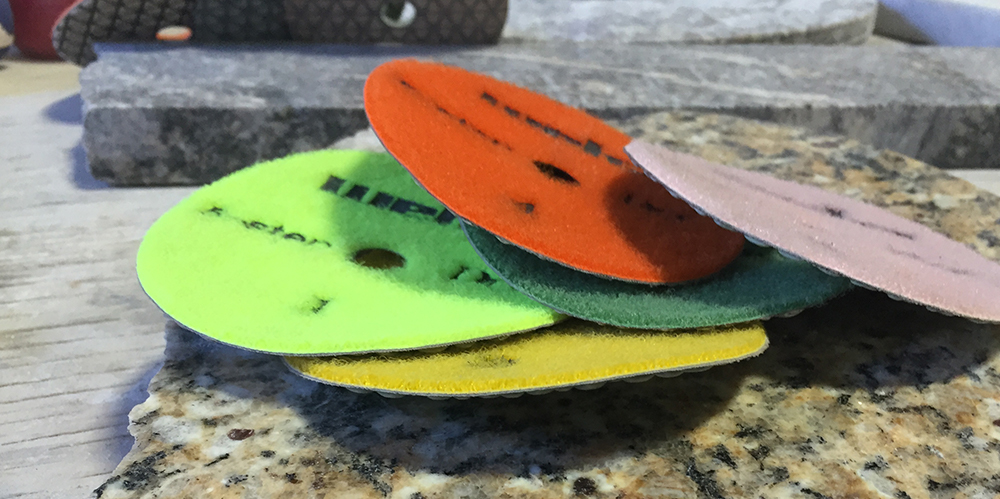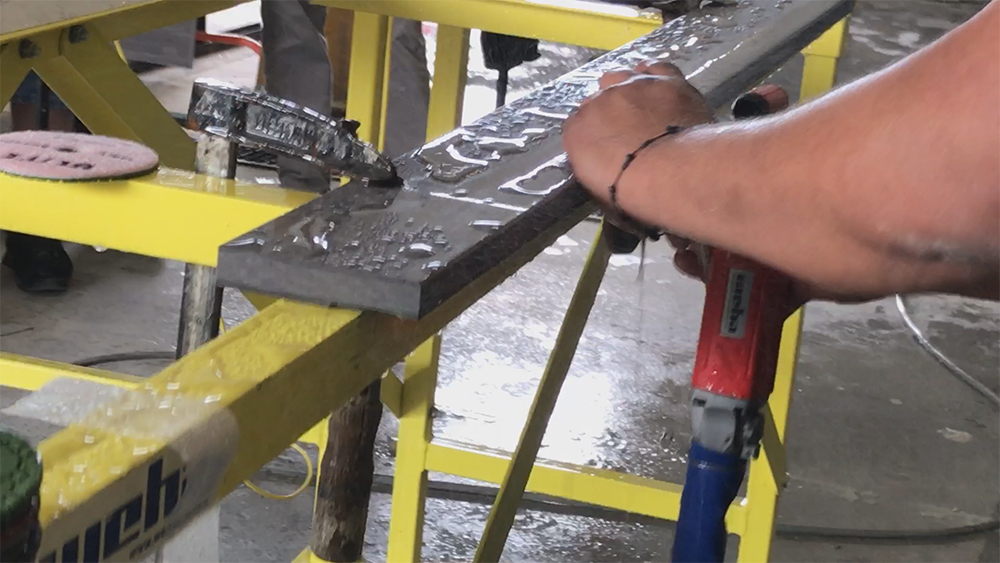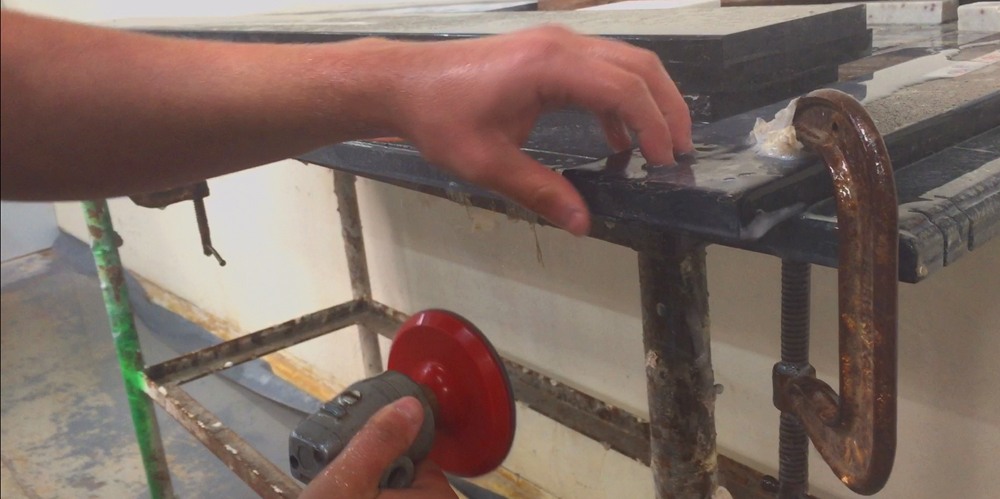What Are the Different Types of Polishing Pads
When it comes to polishing pad variety, there are a number of ways to examine that question. First, you could discuss the differences in their use. Or, you could look at the characteristics of each of the pads in a set. And there are even more angles you could take when comparing diamond polishing pads. What we will do in this article is consider a variety of ways that one could answer the question: “what are the different types of polishing pads?” Along the way, we will try to highlight some of the important variations between pads that are used by stone fabricators and installers.

A Difference In Quality
One of the first main variants when it comes to comparing the differences and similarities of polishing pads is the quality. However, there are a number of factors that can affect the quality of a diamond polishing pad. Let’s take a look at just three such factors. Three factors that contribute to a polishing pad’s quality are:
- Kind of Resin Bond
- Performance of the Diamonds
- Flexibility of the Pad
Resin Bond
When it comes to the quality of bond that is used for a given diamond polishing pad, it is important to choose one appropriate for the task. The resin bond that is used for the polishing pad plays a role in the pad’s performance. Why is that the case? Well, the resin must be strong enough to hold the diamonds so they can perform their function. Namely, the cutting of the stone surface.
Additionally, the bond must wear down at a particular rate. As the resin bond wears, it exposes diamonds that were not exposed previously. This process continues as the pad wears down; eventually reaching the end of its life. As you can imagine, the type of resin bond will impact the way the polishing pad wears, cuts, and lasts. As a result, a quality polishing pad will have a resin bond that performs best for the task it was made.
Diamond Quality
Diamonds are used in the stone industry because they are extremely hard. This means that they can cut rock. In fact, a stone’s hardness is measured on the Mohs scale; a scale on which diamond registers at the highest level (10).
Not only is the quality of the diamonds used in the polishing pad important, but also the diamond concentration. This is due to the reason we just mentioned. Since the diamonds are what cuts the stone, then the quantity and quality of these has a direct impact on the polishing pad’s performance.
Pad Flexibility
A polishing pad’s flexibility can be exactly what is needed. And, at other times, it may not be what you are after. For example, if the pad is being used to polish edges that are curved, flexibility is exactly what the fabricator needs. Yet not all pads are flexible.
Other pads that are not flexible may be a good choice for polishing flat surfaces. Since many natural stones are comprised of various minerals, large flat surfaces will most likely vary in hardness. If you are polishing a large flat area with a polishing pad that is flexible your polishing pad’s performance may not be as good as it could be.
Differences in Usage
As we have discussed, differences in the quality of the pads can be affected by various charactristics (or properties) of the pad. However, we also established that various attributes contribute to the way a polishing pad performs. This means that polishing pads can be designed to work well for specific uses.

Wet Diamond Polishing Pads
One type of use that polishing pads are designed for is wet polishing. Wet polishing pads are designed for use in a fabrication shop while water is being applied to the surface being polished. As you can imagine, high speed polishing with resin pads causes friction. This friction heats up the pad and the stone. Water is used to keep the temperature from climbing to a point that can hinder the polishing process.
Dry Diamond Polishing Pads
Although many polishing pads are used in a wet environment, there are others that get used in a dry environment. This is the case when a stone installer needs to touch up a stone that is all ready in a home. When stone professionals are working on a stone that is in a person’s home, it is not practical to set up a wet environment in which to polish with wet pads. In these scenarios, the dry polishing pads are the solution.
Hand Polishing Pads
Still different from the other pads mentioned is the hand polishing pads. These pads work differently than the grinder polishing pads. Hand polishing pads do not fasten to a tool. Rather, they are held in the fabricator or installer’s hand and used to touch up stone that get’s nicked or scuffed from a tool that was used during the installation or fabrication process.
Some stone professionals prefer using diamond hand pads instead of angle grinder polishing pads. This makes sense in some cases, particularly in cases where the touch up is not large enough to warrant setting up a power tool to correct. As a result, diamond hand polishing pads are often times found on the truck of stone installation professionals.
Different Pads for Different Materials
Each type of stone that is being polished has very distinct traits. These traits determine which polishing pads will work better on the stone. Let’s take a look at some scenarios that highlight this point.

Polishing Pads for Quartz
Enigneered stone brings with it some specific characteristics. One such characteristic is the fact that engineered stone contains resin. Engineered stone is also known as “quartz”. The process consists of combining natural quartz materials with a little bit of resin to form a slab of material that can be referred to as natural stone. The presence of the resin though, means that polishing the stone will require a pad designed not to burn the resin. By using a polishing pad designed for polishing quartz materials or engineered stone, you save yourself extra work. Namely, having to correct issues that could arise during the polishing process.
Polishing Pads for Marble
Other materials that warrant a specific kind of polishing pad are stones that fall into the “soft” category. This category includes the following natural stone:
- Marble
- Limestone
- Travertine
- Onyx
These so-called “soft stones” can clog up some polishing pads during polishing. So, it might be wise to select a polishing pad that is designed to effectively polish these specific stone materials.
What Polishing Pads to Use
As you can see from what we have considered here, what polishing pad to use depends on a number of factors. We have looked at how the design of the polishing pad plays a part in selecting it. Additionally, we took a look at how different environments will call for different polishing pads. We also considered the type of tool that the professional will use the polishing pad with. And finally, we examined the kinds of stones that fabricators and installers polish.
Gauging which polishing pad(s) you will need will likely involve a variety of these factors. However, there are a number of stone fabrication distributors ready and willing to provide you with whichever diamond polishing pads you determine that you need.
